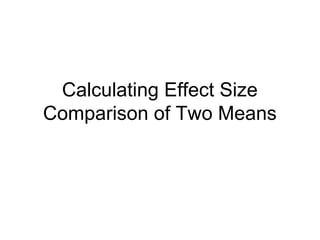Effectsizepresentation 110118093101-phpapp01-130629114308-phpapp02
- 1. Calculating Effect Size Comparison of Two Means
- 2. 1 X 2 X n df SD1 SD2 t p value 30 28 4.6 4.1 2.3 2.3 0.60 0.56 60 58 4.6 4.1 2.3 2.3 0.84 0.4 100 98 4.6 4.1 2.3 2.3 1.09 0.28 500 498 4.6 4.1 2.3 2.3 2.43 0.02* 1000 998 4.6 4.1 2.3 2.3 3.44 0.00*
- 3. Criticism on NHST ŌĆó 1. NHST does not provide the information which the researcher wants to obtain ŌĆó 2. Logical problems derived from the probabilistic nature of NHST. ŌĆó 3. NHST does not enable psychological theories to be tested. ŌĆó 4. The fallacy of replication. ŌĆó 5. NHST fails to provide useful information because H0 is always false. ŌĆó 6. Problems associated with the dichotomous decision to reject/not reject the H0. ŌĆó 7. NHST impedes the advance of knowledge.
- 4. Effect Size ŌĆó Cohen (1988) defines the effect size as the extent to which the phenomenon is found within the population or, in the context of statistical significance testing, the degree to which the H0 is false. ŌĆó Snyder and Lawson (1993) argue that the effect size indicates the extent to which the dependent variable can be controlled, predicted and explained by the independent variable(s).
- 5. Effect Size Measures ŌĆó Effect size measures of Two In/dependent Groups ŌĆō CohenŌĆÖs d ŌĆō Hedges g ŌĆō Glass Delta ŌĆó Correlation Measure of Effect Size ŌĆō r ŌĆō Žć2 Ō¢║╬”; t Ō¢║ r; F Ō¢║ r; d Ō¢║ r ŌĆó Effect size for Analysis of Variance ŌĆō Eta Squared ŌĆō Omega Square Index of Strength ŌĆō Intercalss correlation
- 6. 2 2 2 1 2 21 ss MMd + ŌłÆ= 2 2 2 1 1 2 21 n s n s MMt + ŌłÆ= CohenŌĆÖs d Formula t-test for independent Means Formula
- 7. Computation A research compared first year public and private school students in their study habits. Study habits was measured using the Survey of Study Habits. The t-test for two independent samples was used to determine the significant difference between the students in the public and private school in the four factors of study habits. The following statistical output was obtained:















